Flags of the Confederate States of America
There were several flags of the Confederate States of America used during its existence from 1861 to 1865. Since the end of the American Civil War, personal and official use of Confederate flags, and of flags derived from these, has continued under some controversy.
The state flags of Mississippi, Georgia, Arkansas, and Tennessee are all based on confederate flags. The flag of North Carolina is based on the state's 1861 flag which dates back to the confederacy and appears to be based on the first confederate flag.
Some people believe that the flag of Alabama and perhaps the flag of Florida are of confederate inspiration, although this is disputed.
Contents |
National flags
First national flag ("the Stars and Bars")
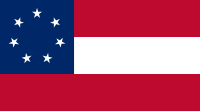
The first official flag of the Confederacy, called the "Stars and Bars," was flown from March 5, 1861 to May 26, 1863.
The very first national flag of the Confederacy was designed by Prussian artist Nicola Marschall in Marion, Alabama.[1] The Stars and Bars flag was adopted March 4, 1861 in Montgomery, Alabama and raised over the dome of that first Confederate Capitol. Marschall also designed the Confederate uniform.[2]
One of the first acts of the Provisional Confederate Congress was to create the Committee on the Flag and Seal, chaired by William Porcher Miles of South Carolina. The committee asked the public to submit thoughts and ideas on the topic and was, as historian John M. Coski puts it, "overwhelmed by requests not to abandon the 'old flag' of the United States." Miles had already designed a flag that would later become the Confederate battle flag, and he favored his flag over the "Stars and Bars" proposal. But given the popular support for a flag similar to the U.S. flag ("the Stars and Stripes"), the Stars and Bars design was approved by the committee.[3] When war broke out, the Stars and Bars caused confusion on the battlefield because of its similarity to the U.S. flag of the U.S. Army.[4]
Eventually, a total of thirteen stars would be shown on the flag. Its first public appearance was outside the Ben Johnson House in Bardstown, Kentucky. It was also used as a naval ensign.
Second national flag ("the Stainless Banner")

The second national flag of the Confederacy, called the "Stainless Banner," was put into service on May 1, 1863. It was designed to replace the first national flag. The first national flag had become increasingly criticized for its similarity to the Stars and Stripes, even though this had been the main argument for its initial adoption.[5] The flag is sometimes referred to as the "Stonewall Jackson Flag" because of its inaugural use covering Stonewall Jackson's coffin at his funeral.
Many designs were proposed, nearly all making use of the battle flag, which by 1863 had become well-known and popular. The new design was specified by the Confederate Congress to be a white field "with the union (now used as the battle flag) to be a square of two-thirds the width of the flag, having the ground red; thereupon a broad saltier [sic] of blue, bordered with white, and emblazoned with mullets or five-pointed stars, corresponding in number to that of the Confederate States."[6]
The nickname "stainless" referred to the pure white field. The flag act of 1864 did not state what the white symbolized and advocates offered various interpretations. The most common interpretation is that the white field symbolized the purity of the Cause. The Confederate Congress debated whether the white field should have a blue stripe and whether it should be bordered in red. William Miles delivered a speech for the simple white design that was eventually approved. He argued that the battle flag must be used, but for a national flag it was necessary to emblazon it, but as simply as possible, with a plain white field.[7]
The flags actually made by the Richmond Clothing Depot used the 1.5:1 ratio adopted for the naval ensign rather than the official 2:1 ratio.[8]
Initial reaction to the second national flag was favorable, but over time it became criticized for being "too white". The Columbia Daily South Carolinian observed that it was essentially a battle flag upon a flag of truce and might send a mixed message. Military officers voiced complaints about the flag being too white, for various reasons, including the danger of being mistaken as a flag of truce, especially on naval ships, and that it was too easily soiled.[9]
Third National Flag

The third national flag was adopted March 4, 1865, just before the fall of the Confederacy. The red vertical stripe was proposed by Major Arthur L. Rogers, who argued that the pure white field of the second national flag could be mistaken as a flag of truce. When hanging limp in no wind, the colored corner of the flag could be accidentally hidden, so the flag could easily appear all white.
Rogers lobbied successfully to have his design introduced in the Confederate Senate. He defended his design as having "as little as possible of the Yankee blue", and described it as symbolizing the primary origins of the people of the South, with the cross of Britain and the red bar from the flag of France.[9]
The Flag Act of 1865 describes the flag in the following language: "The Congress of the Confederate States of America do enact, That the flag of the Confederate States shall be as follows: The width two-thirds of its length, with the union (now used as the battle flag) to be in width three-fifths of the width of the flag, and so proportioned as to leave the length of the field on the side of the union twice the width of the field below it; to have the ground red and a broad blue saltire thereon, bordered with white and emblazoned with mullets or five pointed stars, corresponding in number to that of the Confederate States; the field to be white, except the outer half from the union to be a red bar extending the width of the flag."[10]
Other flags
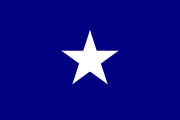
Unofficial Southern Flag
In addition to the national flags, a wide variety of flags and banners were flown by Southerners during the War. Most famously, the "Bonnie Blue Flag" was used as an unofficial flag during the early months of 1861. In addition, many military units had their own regimental flags they would carry into battle. Other notable flags used are shown below.
The Battle Flag
Often referred to as "The" battle flag of the Confederacy it was the design that was the basis of more than 180 separate Confederate military battle flags.
The Army of Northern Virginia battle flag was usually square, of various sizes for the different branches of the service: 48 inches square for the infantry, 36 inches for the artillery, and 30 inches for the cavalry. It was used in battle beginning in December 1861 until the fall of the Confederacy. The blue color on the saltire in the battle flag was navy blue, as opposed to the much lighter blue of the Naval Jack.
The flag's stars represented the number of states in the Confederacy. The distance between the stars decreased as the number of states increased, reaching thirteen when the secessionist factions of Missouri and Kentucky joined in late 1861.[11]
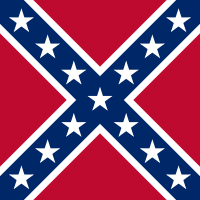
At the First Battle of Bull Run, the similarity between the Stars and Bars and the Stars and Stripes caused confusion and military problems. Regiments carried flags to help commanders observe and assess battles in the warfare of the era. At a distance, the two national flags were hard to tell apart. In addition, Confederate regiments carried many other flags, which added to the possibility of confusion. After the battle, General P.G.T. Beauregard wrote that he was "resolved then to have [our flag] changed if possible, or to adopt for my command a 'Battle flag', which would be Entirely different from any State or Federal flag."[4] He turned to his aide, who happened to be William Porcher Miles, the former chair of Committee on the Flag and Seal. Miles described his rejected national flag design to Beauregard. Miles also told the Committee on the Flag and Seal about the general's complaints and request for the national flag to be changed. The committee rejected this idea by a four to one vote, after which Beauregard proposed the idea of having two flags. He described the idea in a letter to his commander General Joseph E. Johnston: "I wrote to [Miles] that we should have two flags — a peace or parade flag, and a war flag to be used only on the field of battle — but congress having adjourned no action will be taken on the matter — How would it do us to address the War Dept. on the subject of Regimental or badge flags made of red with two blue bars crossing each other diagonally on which shall be introduced the stars, ... We would then on the field of battle know our friends from our Enemies."[4]

The flag that Miles had favored when he was chair of the Committee on the Flag and Seal eventually became the battle flag and, ultimately, the most popular flag of the Confederacy. According to historian John Coski, Miles' design was inspired by one of the many "secessionist flags" flown at the South Carolina secession convention of December, 1860. That flag was a blue St George's Cross (an upright or Latin cross) on a red field, with 15 white stars on the cross, representing the slave states, and, on the red field, palmetto and crescent symbols. Miles received a variety of feedback on this design, including a critique from Charles Moise, a self-described "Southerner of Jewish persuasion". Moise liked the design, but asked that "the symbol of a particular religion not be made the symbol of the nation." Taking this into account, Miles changed his flag, removing the palmetto and crescent, and substituting a heraldic saltire ("X") for the upright one. The number of stars was changed several times as well. He described these changes and his reasons for making them in early 1861. The diagonal cross was preferable, he wrote, because "it avoided the religious objection about the cross (from the Jews and many Protestant sects), because it did not stand out so conspicuously as if the cross had been placed upright thus." He also argued that the diagonal cross was "more Heraldric [sic] than Ecclesiastical, it being the 'saltire' of Heraldry, and significant of strength and progress."[12]
Although Miles described his flag as a heraldic saltire, it had been thought to be erroneously described since the latter part of the 19th century as a cross, specifically a Saint Andrew's Cross. Supposedly this folk legend sprang from the memoirs of an aging Confederate officer published in 1893. However, further research has indicated that this was no folk legend. In 1863, during the session in which the Confederate Congress was voting on the 2nd National Flag, William G. Swan of Tennessee's second congressional district wished to substitute the following language:
"That the flag of the Confederate States shall be as follows:
A red field with a Saint Andrew's cross of blue edged with white and emblazoned with stars."
Swan, who before the secession had been mayor of Knoxville and attorney general of Tennessee, had adapted his proposal from the battle flag of the Army of Northern Virginia, but it was in fact identical to the flag proposed by William Porcher Miles in March 1861. Because he believed that the battle flag had been sanctified by the blood of Southern soldiers in their struggle for independence, Swan wished to adopt it for use by the nation now as a tribute to the valor of the Confederate fighting man. Further references to the link between the battle flag and the St. Andrew's Cross are made by Confederate soldiers during the war.
According to Coski, the Saint Andrew's Cross had no special place in Southern iconography at the time, and if Miles had not been eager to conciliate the Southern Jews his flag would have used the traditional Latin, Saint George's Cross. A colonel named James B. Walton submitted a battle flag design essentially identical to Miles' except with an upright Saint George's cross, but Beauregard chose the diagonal cross design.[13]
Specifically, the St. Andrew's Cross is a white saltire on a blue field, as in the national flag of Scotland. The St. Patrick's Cross, as in the state flag of Alabama, is a red saltire on a white field. The Army of Northern Virginia battle flag has a blue saltire on a red field and is, therefore, neither the St. Andrew's nor the St. Patrick's Cross but a saltire as in the proposed but unadopted Second National flag.
Miles' flag, and all the flag designs up to that point, were rectangular ("oblong") in shape. General Johnston suggested making it square instead to conserve material. Johnston also specified the various sizes to be used by different types of military units. Generals Beauregard and Johnston and Quartermaster General Cabell approved the design of the 12-star Confederate Battle Flag at the Ratcliffe home, which served briefly as Beauregard’s headquarters, near Fairfax Court House in September 1861. The 12th star represented Missouri. President Jefferson Davis arrived by train at Fairfax Station soon after and was shown the design for the new battle flag at the Ratcliffe House. Hetty Cary and her sister and cousin made prototypes. One such 12-star flag resides in the collection of Richmond’s Museum of the Confederacy and the other is in Confederate Memorial Hall in New Orleans.
On November 28, 1861, Confederate soldiers in the Army of the Potomac (later called the Army of Northern Virginia) received the new battle flags in ceremonies at Centreville and Manassas, Virginia, and carried them throughout the Civil War. Beauregard gave a speech encouraging the soldiers to treat this new flag with honor and that it must never be surrendered. Many soldiers wrote home about the ceremony and the impression the flag had upon them, the "fighting colors" boosting morale after the confusion at the Battle of First Manassas. From that point on, the battle flag only grew in its identification with the Confederacy and the South in general.[14] Later, a 13th star was added for Kentucky.
The Army of Northern Virginia battle flag assumed a prominent place post-war when it was adopted as the copyrighted emblem of the United Confederate Veterans. Its continued use by the UCV and the later Sons of Confederate Veterans led to the assumption that it was, as it has been termed, "the soldier's flag" or "the Confederate battle flag".
The flag is also properly known as the flag of the Army of Northern Virginia. It was sometimes called "Beauregard's flag" or "the Virginia battle flag". A Virginia Department of Historic Resources marker [15]declaring Fairfax, Virginia, as the birthplace of the Confederate battle flag was dedicated on April 12, 2008, near the intersection of Main and Oak Streets, Fairfax, VA.
The First Confederate Navy Jack consisted of a circle of seven 5-pointed white stars on a field of light blue. The Second Confederate Navy Jack is a rectangular precursor of the battle flag, usually about 5×3 feet. The blue color in the saltire (the diagonal cross) is much lighter than in the battle flag, and it was flown only on Confederate ships from 1863 to 1865.
The design was originally made by South Carolina Congressman William Porcher Miles with the intent to be the first national flag, but it was rejected by the Confederate government. Some critics supposedly scoffed at the design, saying it looked too much like crossed suspenders. While the square battle flag was widely used, the rectangular upside down and, the oblong version was also used by some army units, including the Army of Tennessee as their battle flag from 1864-1865. After General Joseph Johnston took command of the Army of Tennessee from Braxton Bragg, he ordered its army-wide implementation to improve morale and avoid confusion.
The second national flag was adapted as a naval ensign, using a shorter 3:2 ratio than the 2:1 ratio adopted by the Confederate Congress for the national flag. This particular ensign was the only one taken around the world (on board CSS Shenandoah) and was the last Confederate flag lowered in the Civil War (in Liverpool, England on 7 November 1865 on board CSS Shenandoah).
The Confederate Flag
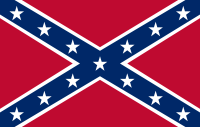
What is now often called "The Confederate Flag" or "The Confederate Battle Flag" (actually a combination of the battle flag's colors with the Second Navy Jack's design), despite its never having historically represented the CSA as a nation, has become a widely recognized symbol of the South. It is also called the "rebel" or "Dixie" flag, and is often incorrectly referred to as the "Stars and Bars" (the actual "Stars and Bars" is the First National Flag, which used an entirely different design).
During the first half of the 20th century the Confederate flag enjoyed renewed popularity. During World War II some U.S. military units with Southern nicknames, or made up largely of Southerners, made the flag their unofficial emblem. Some soldiers carried Confederate flags into battle. After the Battle of Okinawa a Confederate flag was raised over Shuri Castle by a soldier from the self-styled "Rebel Company" (Company A of the 5th Marine Regiment). It was visible for miles and was taken down after three days on the orders of General Simon B. Buckner, Jr. (son of Confederate General Simon Buckner), who stated that it was inappropriate as "Americans from all over are involved in this battle". It was replaced with the flag of the United States.[16]
The use of the flag by soldiers came under investigation after some African-American soldiers filed complaints. By the end of World War II, the use of the Confederate flag in the military was rare.[17] However, the Confederate flag continues to be flown in an unofficial manner by many soldiers. It was seen many times in Korea, Vietnam, and in the Middle East.
Controversy
Displaying the flag
The display of the Confederate flag remains a highly controversial and emotional topic, generally because of disagreement over the nature of its symbolism. Opponents of the Confederate flag, and particularly African Americans see it as an overt symbol of racism, both for the history of racial slavery in the United States, and the establishment of Jim Crow laws by Southern states following the end of Reconstruction in late 1870s, enforcing racial segregation within state borders for nearly a century until the Civil Rights Movement. Supporters of the flag view it as a symbol of heritage and the freedom of the distinct cultural tradition of the South from the perceived oppression of Northern government. Also, in light of some universities banning it as a racist symbol in their "speech codes", it could also be seen as a symbol of freedom of speech. Some hate groups use the Southern Cross as one of the symbols associated with their organizations, including racist groups such as the Neo-Nazis and the Ku Klux Klan.[18] The flag is also sometimes used by separatist organizations such as the Aryan Nations. It is important to note, however, that the official flag of the Ku Klux Klan, as stated by this organization itself, is the flag of the United States of America, not the CSA battle flag. The Aryan Nation also uses the U.S. flag as well as the Christian flag displayed in Protestant churches.
White southerners often see the flag as merely a symbol of southern culture, a "country music flag" without any political or racial connotation. An example of this would be the Bocephus Rebel Flag often sold at concerts performed by country music star Hank Williams, Jr., and southern rock band Lynyrd Skynyrd. For some, the flag represents only a past era of southern sovereignty.[19] Some historical societies such as the Sons of Confederate Veterans and the United Daughters of the Confederacy also use the flag as part of their symbols. Also rockabilly fans hold the Confederate flag as their emblem. The flag has also been used as a symbol of generalized working-class masculinity, suggesting rowdy rebelliousness, and detached from any intended historical, Southern regional, or racial significance, although almost always in a white context, such as construction workers in Montreal[20].
As a result of these varying perceptions, there have been a number of political controversies surrounding the use of the Confederate flag in Southern state flags, at sporting events, at Southern universities, and on public buildings. According to Civil War historian and native Southerner Shelby Foote, the flag traditionally represented the South's resistance to Northern political dominance; it became racially charged during the Civil Rights Movement of the 1950s and 1960s, when fighting against desegregation suddenly became the focal point of that resistance.
Symbols of the Confederacy remain a contentious issue across the United States and have been debated vigorously in many Southern state legislatures over their civic placement since the 1990s.
Display at the South Carolina capitol
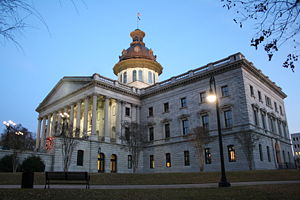
On April 12, 2000, the South Carolina State Senate passed a bill to remove the Confederate flag from the top of the State House dome by a majority vote of 36 to 7. Originally placed there in 1962,[21] "the new bill specified that a more traditional version of the battle flag would be flown in front of the Capitol next to a monument honoring fallen Confederate soldiers." The bill also passed the state's House of Representatives, but not without some difficulty. On May 18 2000, after the bill was modified to ensure that the height of the flag's new pole would be 30 feet (9 m), it was passed by a majority of 66 to 43. Governor Jim Hodges signed the bill into law five days later after it passed the state Senate. On July 1 2000 the flag was removed from atop the State House and placed on a monument on the front lawn of the capitol. Current state law prohibits the flag's removal from the State House grounds without additional legislation.
In 2005, two Western Carolina University researchers found that 74% of African-Americans polled favored removing the flag from the South Carolina State House altogether.[22] The NAACP and other civil rights groups have attacked the flag's continued presence at the state capitol. The NAACP maintains an official boycott of South Carolina, citing its continued display of the battle flag on its State House grounds, despite an initial agreement to call off the boycott after it was removed from the State House dome.
The National Collegiate Athletic Association has prevented South Carolina from hosting any championship sporting events in which the sites are determined in advance.[23] On April 14, 2007, Steve Spurrier, coach of the University of South Carolina football team, made an acceptance speech for a community service award in which he referred to the flag on the State House grounds as "that damn flag".[24]
Use in State Flags
Alabama

It is commonly believed that the crimson saltire of the Flag of Alabama was designed to resemble the blue saltire of the Confederate Battle Flag. The Battle Flag was square-shaped, and Alabama's flag is sometimes shown as a square. The legislation that created the state flag did not specify if the flag was going to be square or rectangular.[25] The authors of a 1917 article in National Geographic expressed their opinion that because the Alabama flag was based on the Battle Flag, it should be square.[26] In 1987, the office of Alabama Attorney General Don Siegelman issued an opinion in which the Battle Flag derivation is repeated, but concluded that the proper shape is rectangular, as it had been depicted numerous times in official publications and reproductions.[27]
However, the saltire design of the Alabama state flag also bears resemblance to several other flags. It is identical to the flag of Saint Patrick, incorporated into the Union Flag of the United Kingdom to represent the union of the Kingdom of Great Britain with the Kingdom of Ireland. This has led to other origins being put forth as possibilities.
Some hold that it owes its origin as a simplification of the Cross of Burgundy Flag used by the Spanish in the New Spain and as the basis of military flags. One example that was used in the future Alabama was that of the Regimiento de Infanteria de Luisiana which took part in the Battle of Mobile as part of the Gulf Coast campaign of the American Revolution. [28]
Another slim possibility is in the flag of Co. F 7th Alabama Cavalry. The regiment was the only Alabama regiment in Rucker's Brigade commanded by Col. Edmund Rucker of Tennessee, later Alabama, who became a prominent Montgomery businessman after the war. The flag of the brigade used a white background with a red saltire which did not always extend to the corners and charged with dark colored stars upon the saltire. The flag of Co. F, 7th Alabama Cavalry is currently held by the Alabama Department of Archives and History as part of its Alabama Civil War Period Flag Collection. [29] But, the flag carried by Co. F 7th Alabama was not an Alabama Flag, it was the flag made for Rucker's Brigade a month before the 7th joined his brigade; the 7th was color party only after September 24, 1864. A bunting flag that exists, in the white and red configuration with 13 blue stars, is not believed to be Alabama associated, but tied to Rucker's Brigade also.
Florida
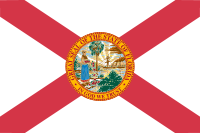
Some have claimed that the cross is intended to recall the blue saltire of the Confederate Battle Flag. However, this view is not universal and there is no significant opposition to the current design within the state (as there has been in Georgia and Mississippi over their Confederate-style flags). Historically, the first Spanish flag over Florida was a red saltire ragulée (knotted) with a white background (the Burgundian Saltire). The flag of Alabama is a plain red saltire, as is Saint Patrick's Flag, which is incorporated into the Union Flag of the United Kingdom.
Georgia
In 1956, the State Flag of Georgia was redesigned to incorporate the Confederate Battle Flag. Following protests over this aspect of the design in the 1990s by the National Association for the Advancement of Colored People (NAACP) and other groups, efforts began in the Georgia General Assembly to remove the Battle Flag from the state flag's design. These efforts succeeded in January 2001 when Georgia Governor Roy Barnes pushed through a design that, though continuing to depict the Battle Flag, greatly reduced its prominence. This move deeply angered a large segment of Georgia’s electorate, contributing to Barnes' defeat in the subsequent gubernatorial election in November 2002.
The following year, amidst demands for the return of the 1956 design (“Battle Flag” version) and opposing demands for the continued use of the new “Barnes’” design, the Georgia General Assembly redesigned the flag yet again, adopting a "compromise" design based largely on the First National Flag of the Confederacy (known as the "Stars and Bars").

Mississippi
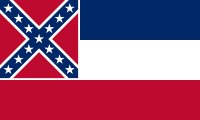
The Confederate Battle Flag became a part of the Flag of Mississippi in 1894. In 1906, the flag statutes were omitted by error from the new legal code of the state, leaving Mississippi without an official flag. The omission was not discovered until 1993, when a lawsuit filed by the NAACP regarding the flag was being reviewed by the Mississippi Supreme Court. In 2000, Governor Ronnie Musgrove issued an executive order making the flag official. After continued controversy, the decision was turned over to citizens of the state, who, on April 17, 2001, voted 2:1 to keep the Confederate Battle Flag emblem on the state flag.[30]
North Carolina
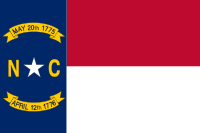
The state legislature adopted this flag in March, 1885, to replace the original state flag that had been adopted on June 22, 1861, immediately following the state's secession from the Union on May 20, 1861. The red field of the old flag was replaced by blue in memory of the Bonnie Blue Flag which was used as a symbol of secession during the war. The overall stripe pattern is also reminiscent of the "Stars and Bars" flag.
Tennessee

The Flag of Tennessee is remiscent of the battle flag in its overall colour scheme and design. The vertical bar on the fly is remiscent of the third confederate flag.
The emblem of the middle consists of three stars on a blue circle. The flag was designed by Colonel LeRoy Reeves of the Tennessee National Guard. The Tennessee State Legislature officially adopted the flag on April 17, 1905. The flag was first raised on October 10, 1911 during the dedication ceremonies for East Tennessee State Normal School in Johnson City.
Use on vehicular license plates
In Alabama, Georgia, Louisiana, Maryland, Mississippi, North Carolina, South Carolina, Tennessee, and Virginia, vehicle owners can request a state-issued license plate featuring the Sons of Confederate Veterans logo, which incorporates the square Confederate battle flag.[31]
In 1998, a North Carolina appellate court upheld the issuance of such license plates in the case SONS OF CONFEDERATE v. DMV, noting: "We are aware of the sensitivity of many of our citizens to the display of the Confederate flag. Whether the display of the Confederate flag on state-issued license plates represents sound public policy is not an issue presented to this Court in this case. That is an issue for our General Assembly."[32] Presently, efforts are also being made in Florida to have an SCV flag featuring the Confederate banner issued by the state.
See also
- Flags of the U.S. states
- Grand Union Flag
- Bonnie Blue Flag
- Confederate Seal
Notes
- ↑ Hume, Erskine (August 1940). "The German Artist Who Designed the Confederate Flag and Uniform". The American-German Review.
- ↑ Nicola Marschall
- ↑ (Coski 2005, pp. 4-5)
- ↑ 4.0 4.1 4.2 (Coski 2005, p. 8)
- ↑ (Coski 2005, p. 15)
- ↑ ([[#CITEREFCoskiThe Second Confederate National Flag], Flags of the Confederacy|Coski The Second Confederate National Flag], Flags of the Confederacy]])
- ↑ (Coski 2005, pp. 16-17)
- ↑ The Second Confederate National Flag, Flags of the Confederacy
- ↑ 9.0 9.1 (Coski 2005, pp. 17-18)
- ↑ The Third Confederate National Flag, Flags of the Confederacy
- ↑ (Coski 2005, p. 11)
- ↑ (Coski 2005, p. 5) describes the 15 stars and the debate on religious symbolism
- ↑ (Coski 2005, pp. 6-8)
- ↑ (Coski 2005, p. 10)
- ↑ [1]
- ↑ (Coski 2005, p. 91)
- ↑ (Coski 2005, pp. 92-94)
- ↑ [2]
- ↑ "Symbols and the world system: National anthems and flags", KA Cerulo - Sociological Forum, 1993 - Springer
- ↑ http://bad.eserver.org/issues/2006/74/rentschler.html
- ↑ Brunner, Borgna (2000-06-30). "South Carolina's Confederate Flag Comes Down". Retrieved on 2007-04-19.
- ↑ Cooper, Christopher A.; Knotts, H. Gibbs (2006), "Beyond Dixie: Race, Region, and Support for the South Carolina Confederate Flag", Social Science Quarterly 87 (2): 9, doi:, http://paws.wcu.edu/ccooper/beyonddixie.pdf
- ↑ "NCAA EXECUTIVE COMMITTEE APPROVES RESOLUTION REGARDING SOUTH CAROLINA'S CONFEDERATE FLAG ISSUE" (2000-04-28). Retrieved on 2007-05-5.
- ↑ Associated Press (2007-04-16). "Spurrier: Flag should come down from S.C. Statehouse". Retrieved on 2007-05-5.
- ↑ Alabama Department of Archives & History (2007). "State Flag of Alabama". Retrieved on 2007-11-17.
- ↑ *Lt. Commander Byron McCandless & Gilbert Grosvenor. "Flags of the World." National Geographic Magazine. Vol 32. No. 4, pp. 281-420 (October 1917).
- ↑ Don Siegelman (1987). "Opinion of Don Siegelman" (PDF). Office of the Attorney General of the State of Alabama. Retrieved on 2007-11-17.
- ↑ Flags of the World "Louisiana Infantry 1779-1781 (Spain)"
- ↑ Flag: Rucker's Brigade (Carried by Co. F, 7th Alabama Cavalry) Catalogue No. 86.1876.1
- ↑ Mississippi votes 2-1 to keep existing flag, CNN.com
- ↑ Plate images for Georgia, North Carolina, Alabama, Maryland, Mississippi, South Carolina, Tennessee, and Virginia
- ↑ SONS OF CONFEDERATE v. DMV
References
- Coski, John M. (2005), The Confederate Battle Flag: America's Most Embattled Emblem, The Belknap Press of Harvard University Press, ISBN 0-674-01722-6
External links
- 1860s Harper's Weekly Images Containing Confederate Flag
- Flags of the Confederacy website
- The Flags of Bentonville: Union and Confederate flags that flew with units at the Battle of Bentonville, March 1865
- Georgia secession flags
- Birthplace of the Confederate Battle Flag marker
- Resolution unanimously adopted in 1989 by Sons of Confederate Veterans deploring use of the Confederate Battle Flag by hate groups
- 2000 resolution supporting display of Confederate Battle Flags adopted by the Sons Of Union Veterans of the Civil War
|
|||||